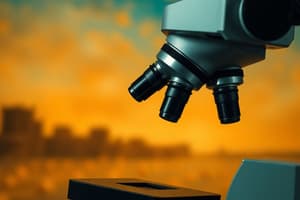Podcast
Questions and Answers
What is the function of the oculars in a microscope?
What is the function of the oculars in a microscope?
- To magnify the image for viewing (correct)
- To control the focus of the microscope
- To adjust the brightness of the light source
- To hold the slide in place
How can you determine the total magnification of an object in a microscope?
How can you determine the total magnification of an object in a microscope?
- By dividing the ocular lens magnification by the objective lens magnification
- By adding the ocular and objective lens magnifications
- By taking the average of the ocular and objective lens magnifications
- By multiplying the ocular lens magnification with the objective lens magnification (correct)
Which part of the microscope is primarily responsible for maintaining the stability of the system?
Which part of the microscope is primarily responsible for maintaining the stability of the system?
- The arm
- The head
- The base (correct)
- The stage
What is the purpose of the stage in a microscope?
What is the purpose of the stage in a microscope?
Which of the following is NOT contained within the arm of the microscope?
Which of the following is NOT contained within the arm of the microscope?
What characterizes a critical nonconformity in healthcare?
What characterizes a critical nonconformity in healthcare?
How is a major nonconformity defined?
How is a major nonconformity defined?
What situation may lead to a minor nonconformity being upgraded to a major one?
What situation may lead to a minor nonconformity being upgraded to a major one?
What constitutes a minor nonconformity in a healthcare setting?
What constitutes a minor nonconformity in a healthcare setting?
What is the implication of a major nonconformity on patient safety?
What is the implication of a major nonconformity on patient safety?
Flashcards are hidden until you start studying
Study Notes
Major Components of the Microscope
- Head: Contains oculars (eyepieces) with 10X magnification and the nosepiece, connecting to objective lenses.
- Oculars: Binocular design allows for interpupillary distance adjustment, enhancing field of view.
- Objectives: Multiple lenses with varying magnifications, usually labeled 10X (low power), 20X, 40X (high dry), and 100X (oil immersion).
- Magnification Calculation: Total magnification = ocular lens power × objective lens power (e.g., 10X ocular × 10X objective = 100X total magnification).
- Arm: Supports the stage, stage controls, adjustment knobs, and condenser diaphragm.
- Stage: Holds the slide in place with clips; moved using side stage control knobs.
- Adjustment Knobs: Coarse and fine knobs for vertical stage movement to achieve focus.
- Condenser Diaphragm: Controls light illumination on the specimen; adjustable to vary light angle, affecting contrast and depth of field.
- Base: Provides support; houses field diaphragm, illuminator (light source), and power switch.
- Field Diaphragm: Regulates light entering the condenser, critical for achieving clear images.
Care and Maintenance of the Microscope
- Cleaning Frequency: Clean as necessary; yearly maintenance is compulsory for optimal function.
- Documentation: Record all maintenance according to facility’s standard operating procedures (SOP).
- Dust Protection: Cover the microscope after use to prevent dust accumulation.
Moving the Microscope
- Carrying Method: Always use two hands—grasp the arm with one hand and support the base with the other.
- Preparation: Unplug and secure the power cord; rotate head inward if applicable.
- Transport: Carry close to the body or utilize a cart for longer distances.
Cleaning Procedure
- Start cleaning at the top and work downwards.
- Use a moistened cotton swab or lens paper with cleaning solution for oculars, cleaning in circular motions.
- Clean condenser diaphragm lenses by lowering the stage.
- Use facility-recommended cleaner for the stage to avoid dragging oils onto slides.
Replacing the Bulb
- Unplug the microscope and wait for the bulb to cool (approximately 15 minutes).
- Handle bulbs carefully, avoiding finger contact which can leave smudges.
- Follow manufacturer guidelines for proper bulb replacement.
Maintenance Best Practices
- Prepare necessary cleaning supplies beforehand.
- Clean the stage and objectives when using new slides.
- Cover the microscope post-cleaning and after use.
- Adhere to manufacturer instructions for maintenance tasks.
- Document all maintenance actions according to SOP and consult a supervisor for any uncertainties.
Nonconformity Categories in Healthcare
-
Critical Nonconformity
- Represents a risk to the health and safety of individuals.
- Results from a healthcare provider's failure to comply with standards that could lead to serious injury, harm, impairment, or death.
-
Major Nonconformity
- Indicates absence of essential system elements or significant doubt regarding the quality of products, safety, or services.
- Involves a collection of major non-conformities that reveal inadequate system implementation or effectiveness.
- Persistent minor non-conformities can be reclassified as major if not corrected.
- Based on objective evidence, it may lead to unacceptable risks of patient harm and failure to meet minimum care standards.
-
Minor Nonconformity
- Refers to lapses in discipline or control in procedures, not indicating a systemic breakdown.
- Assures that overall system requirements are defined, implemented, and functionally effective.
Studying That Suits You
Use AI to generate personalized quizzes and flashcards to suit your learning preferences.




